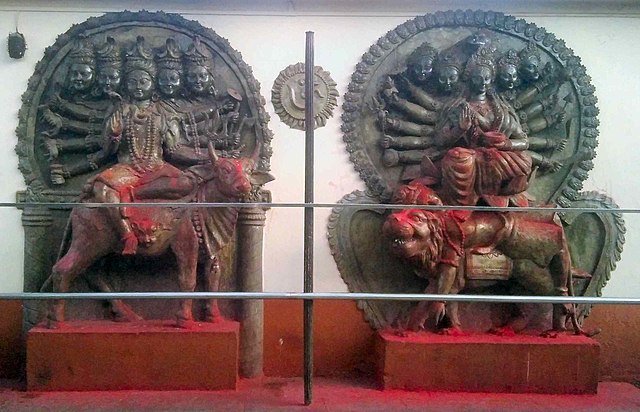Kundalini yoga derives from kundalini, defined in tantra as energy that lies within the body, frequently at the navel or the base of the spine. In normative tantric systems, kundalini is considered to be dormant until it is activated and channeled upward through the central channel in a process of spiritual perfection. Other schools, such as Kashmir Shaivism, teach that there are multiple kundalini energies in different parts of the body which are active and do not require awakening. Kundalini is believed by adherents to be power associated with the divine feminine, Shakti. Kundalini yoga as a school of yoga is influenced by Shaktism and Tantra schools of Hinduism. It derives its name through a focus on awakening kundalini energy through regular practice of mantra, tantra, yantra, yoga, laya, haṭha, meditation, or even spontaneously (sahaja).
Indian Tantric illustration of the subtle body channels which kundalini transverses
Drawing of the subtle body in an Indic manuscript showing the energy centres (chakras), the main subtle channels (nadis), and the coiled serpent energy at the base of the spine (kundalini). The serpent is shown again on the left of the drawing.
In Hinduism, kundalini is a form of divine feminine energy believed to be located at the base of the spine, in the muladhara. It is an important concept in Śhaiva Tantra, where it is believed to be a force or power associated with the divine feminine or the formless aspect of the Goddess. This energy in the body, when cultivated and awakened through tantric practice, is believed to lead to spiritual liberation. Kuṇḍalinī is associated with Parvati or Adi Parashakti, the supreme being in Shaktism; and with the goddesses Bhairavi and Kubjika. The term, along with practices associated with it, was adopted into Hatha yoga in the 9th century. It has since then been adopted into other forms of Hinduism as well as modern spirituality and New Age thought.
Kundalini, chakras, and nadis
Statues of Shiva and Shakti at Kamakhya temple, one of the oldest Shakti Peethas, important shrines in Shaktism, the goddess-focused Hindu tradition
Detail of manuscript painting of a yogi in meditation, showing kundalini serpent coiled in belly around sushumna nadi below chakras and the muladhara chakra with its presiding deity Ganesha above it.





